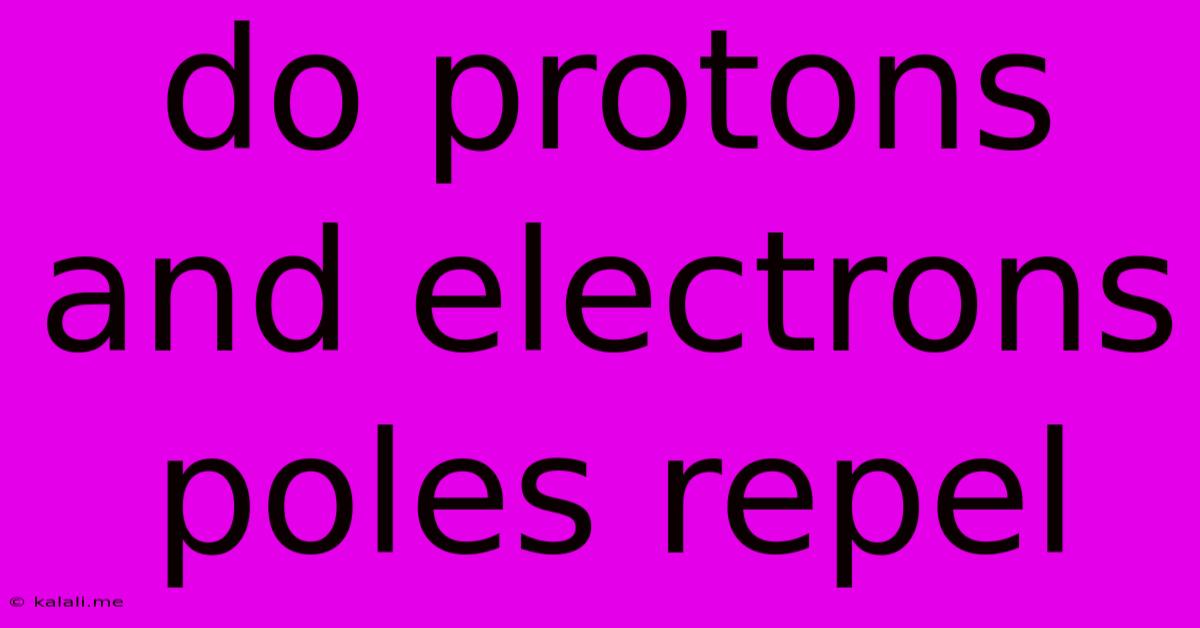Do Protons And Electrons Poles Repel
Kalali
Jun 09, 2025 · 2 min read

Table of Contents
Do Protons and Electrons Poles Repel? Understanding Electrostatic Attraction and Repulsion
This article explores the fundamental interaction between protons and electrons, specifically addressing the question of whether their poles repel. Understanding this interaction is crucial to grasping the basics of electromagnetism and atomic structure. We'll delve into the nature of charge, electrostatic forces, and how these principles govern the behavior of subatomic particles.
The Nature of Charge and Electrostatic Force
Protons possess a positive charge, while electrons carry a negative charge. This inherent property is a fundamental characteristic, much like mass. The electrostatic force, governed by Coulomb's Law, describes the interaction between charged particles. This law states that like charges repel, and unlike charges attract. The strength of this force is directly proportional to the magnitude of the charges and inversely proportional to the square of the distance between them.
Why Protons and Electrons Attract, Not Repel
Given the above, the answer is clear: protons and electrons do not repel; they attract. Because they carry opposite charges, the electrostatic force between them is attractive. This attractive force is what holds electrons in orbit around the nucleus of an atom, counteracting the centrifugal force that would otherwise fling them away. This attractive force is a fundamental component of chemical bonding and the stability of matter.
Understanding Opposite Charges and Attraction
The concept of "poles" in this context isn't directly analogous to the magnetic poles of a magnet. While magnets have distinct north and south poles, the charge of protons and electrons is a scalar quantity, meaning it has magnitude but not direction in the same way. However, we can think of the positive charge of the proton as being "opposite" to the negative charge of the electron, leading to their attraction.
Repulsion Between Like Charges: A Key Contrast
It's important to contrast the proton-electron attraction with the repulsion between like charges. Two protons, both possessing positive charges, will strongly repel each other due to the electrostatic force. Similarly, two electrons, both negatively charged, will also repel. This repulsion plays a significant role in various phenomena, including the stability of atomic nuclei and the behavior of gases.
The Role of the Strong Nuclear Force
While the electrostatic repulsion between protons within the atomic nucleus is significant, it's overcome by the strong nuclear force. This force, significantly stronger than the electrostatic force at short distances, binds protons and neutrons together in the nucleus, preventing the nucleus from flying apart due to electrostatic repulsion.
In Conclusion:
Protons and electrons do not repel; instead, they attract each other due to their opposite charges. This electrostatic attraction is a fundamental force governing atomic structure, chemical bonding, and many other physical phenomena. Understanding this fundamental interaction is key to a deeper understanding of the universe at the atomic level. The repulsion observed is between particles of like charge, highlighting the crucial role of charge in determining the interactions between subatomic particles.
Latest Posts
Latest Posts
-
Resolver Priming Query Complete Timed Out
Jun 09, 2025
-
What 3d Filament Is Microwave Safe
Jun 09, 2025
-
Shot In The Dark Coffee Drink
Jun 09, 2025
-
How To Get Ahead In Math In High School
Jun 09, 2025
-
How Do You Take Scratches Out Of Stainless Steel
Jun 09, 2025
Related Post
Thank you for visiting our website which covers about Do Protons And Electrons Poles Repel . We hope the information provided has been useful to you. Feel free to contact us if you have any questions or need further assistance. See you next time and don't miss to bookmark.